Listen to This Article
Can a small business really get big returns from Google Ads? Absolutely — and this case study proves it. With just a ₹10,000 ad spend, we helped a client generate ₹1.2 lakh in revenue, achieving a 12x return on investment (ROI). We’ll explain our process in detail—step by step—so you can see how it all came together.
The Client
A mid-sized e-commerce business based in India selling personalized gift items. The client approached us with a tight budget and a clear goal: maximize sales while keeping cost-per-acquisition (CPA) low.
Goals
- Spend: ₹10,000
- ROI Target: At least 5x
- Conversion Cost Target: Below ₹100 per sale
- Platform: Google Search & Display Network
Initial Challenges
- High competition on generic keywords
- Low Quality Score due to poor landing page speed
- Poor past experience with Google Ads
Our task was to overcome these and deliver meaningful results with minimal investment.
Strategy & Execution
1. Laser-Focused Keyword Targeting
We avoided broad-match and instead targeted long-tail, high-intent keywords, such as:
- "buy personalized gifts online India"
- "customized mugs with name"
- "photo gifts delivery same day"
These keywords had lower CPCs and higher conversion intent.
2. Location & Device Targeting
Our targeting was refined to major cities like Delhi, Bangalore, and Mumbai for maximum impact. Additionally, we found mobile users converted 25% better, so we allocated 70% of the budget to mobile ads.
3. Landing Page Optimization
We improved page load time, added urgency-driven CTAs like “Only 5 Left!”, and integrated WhatsApp chat for real-time assistance.
4. Compelling Ad Copy
We ran A/B tests on multiple ad variations. The winning copy had:
- “Free Shipping + COD Available”
- “Limited Time Offer – Flat 20% Off”
- Strong call to action: “Shop Now”
5. Retargeting via Display Network
We didn’t stop at search. Retargeting ads brought back visitors who didn’t convert the first time, increasing overall conversions by 18%.
Results (30 Days)
|
|
|
|
|
|
|
|
|
|
|
|
|
|
|
|
|
|
|
|
|
Key Takeaways
✅ Even a small budget can generate massive returns if managed smartly
✅ Long-tail keywords & audience segmentation = higher ROI
✅ Retargeting significantly improves conversion rates
✅ Landing page speed & mobile-first design are crucial for success
✅ What Works Well:
- Result-Driven Title:
It immediately captures attention with real numbers — a classic case of "proof-based" marketing.
- Clear Structure:
Breaking down the story into sections like goals, challenges, strategy, and results makes it easy to read and credible.
- SEO Optimization:
Long-tail keywords like "Google Ads case study India," "small budget Google Ads success," and "₹10,000 Google Ads campaign" are naturally embedded, which supports organic ranking.
- Practical Value:
The step-by-step strategy (keyword targeting, retargeting, etc.) adds educational value, making it shareable and reference-worthy.
- Conversion-Friendly Close:
The CTA at the end invites leads to contact Quantam Minds — without being too pushy.
Opportunities for Improvement:
- Visuals & Data Charts (Optional):
Adding bar charts or infographics can enhance readability and increase time-on-page. I can help design those if needed.
- Client Name (if available):
Mentioning the actual client (with their permission) would enhance authenticity. If privacy is required, you can anonymize with a description (e.g., “a Delhi-based gifting brand”).
- Add Social Proof/Testimonial:
A one-liner quote from the client like “Quantam Minds doubled our revenue!” can build more trust.
- Internal Linking:
If you’re posting this on the Quantam Minds blog, link to your Google Ads services page for better SEO and user flow.
Pros
1. Strong Hook with Real Numbers
- Pro: Using specific figures (₹10,000 → ₹1.2 Lakh) instantly builds curiosity and credibility.
- Why it matters: People trust real outcomes over vague claims.
2. Clear, Actionable Structure
- Pro: Divided into challenges, strategies, and results — easy to follow.
- Why it matters: Enhances reader experience and encourages full reading time (good for SEO).
3. Educational Value
- Pro: Explains Google Ads strategy in detail — targeting, landing pages, copywriting, retargeting.
- Why it matters: Builds authority and increases shareability.
4. Lead Generation-Ready
- Pro: CTA with phone numbers and link to your website.
- Why it matters: Helps turn readers into leads without being pushy.
5. SEO-Friendly Keywords
- Pro: Includes long-tail and localized keywords.
- Why it matters: Supports organic traffic growth from people searching for real case studies or “Google Ads agency India.”
Cons
1. No Visuals or Data Graphics
- Con: All text; no graphs, charts, or images.
- Why it matters: Visual content helps retain attention and makes data easier to digest.
2. Generic Client Description
- Con: No brand name or testimonial from the client.
- Why it matters: Case studies are stronger when they feel authentic. Anonymity can weaken impact slightly.
3. Not Deeply Technical
- Con: Skims over advanced details (e.g., bidding strategies, campaign structure, attribution models).
- Why it matters: For expert audiences, more depth might be expected.
4. Limited Content Repurposing (As Is)
- Con: It’s blog-focused. To use it on platforms like Instagram or YouTube, you’ll need to reformat or break it down.
- Why it matters: Repurposing increases content ROI.
Recommendation:
- Add 1–2 visuals (e.g., revenue growth chart, screenshot of Google Ads dashboard).
- Include a client quote or anonymized testimonial.
- Use this post to:
- Rank on Google.
- Impress clients in your portfolio.
- Generate leads through social sharing.
- Rank on Google.
A well-documented Google Ads case study like “₹10,000 Budget Turned Into ₹1.2 Lakh Revenue” has long-term value far beyond just a blog post. If you use it smartly, it can help drive business growth, boost brand authority, and generate leads consistently.
1. Lead Generation Asset
Create a downloadable PDF version of the case study.
- Offer it as a lead magnet on your website.
- Gate it with a simple form: “Download our winning Google Ads blueprint that made 12x ROI.”
- Grow your email list of potential clients.
2. Sales Enablement Tool
Use in client proposals or presentations
- Include it in pitch decks for PPC clients.
- Helps prove your capability and results.
- Builds trust faster in sales conversations.
3. Multi-Platform Repurposing
Break it into smaller formats for different channels:
|
|
|
|
|
|
|
|
|
 Unlock Your Savings Today!
Unlock Your Savings Today!
Get the best deals with unbeatable service and exclusive offers.

 Grow Your Business with Proven Digital Marketing
Grow Your Business with Proven Digital Marketing
Ready to attract more customers and outshine your competition? Our tailored digital marketing strategies help you rank higher, generate qualified leads, and build a brand people trust. Let’s take your business to the next level.
Digital Marketing Solutions in Leading Cities


 Disclaimer
Disclaimer
The views expressed by experts in this article are their own and do not necessarily reflect the opinions of any website, organization, institution, or affiliated entity. If you have any concerns regarding this article, please contact us at contact@quantamminds.com and also on WhatsApp
Frequently Asked Questions
Can a small Google Ads budget really generate high revenue?
Yes, it’s possible. With the right strategy—such as targeting long-tail keywords, optimizing landing pages, and retargeting warm audiences—even a small budget like ₹10,000 can drive significant sales. Our case study proves a 12x return on investment using just ₹10,000 in ad spend.
What type of business was involved in this Google Ads case study?
This case study involved an Indian e-commerce business that sells personalized gift items. The niche had decent search demand, and the business had the flexibility to run limited-time offers and target high-intent keywords effectively.
What were the key strategies used to get 12x ROI from Google Ads?
We focused on:
- Targeting highly specific, low-competition keywords
- Running mobile-optimized campaigns
- Creating compelling ad copy and urgency-based CTAs
- Retargeting users via the Display Network
- Improving the landing page experience and loading speed
Is Google Ads suitable for beginners or low-budget startups?
Yes, Google Ads offers flexibility to match campaigns with your available budget. With the right targeting and optimization, even startups with small budgets can achieve excellent results. The key is to avoid generic keywords and focus on high-intent, niche audiences.
In what ways can I adapt this case study’s tactics for my own company?
Start by analyzing your audience, identifying high-converting keywords, and creating a clear conversion funnel. Aim for quality-driven campaigns rather than focusing on quantity.. If needed, partner with a performance-driven agency like Quantam Minds to replicate this level of success.








 Ashwani Kumar on 2025-05-20
Ashwani Kumar on 2025-05-20

 Pallavi Singh
Pallavi Singh 



